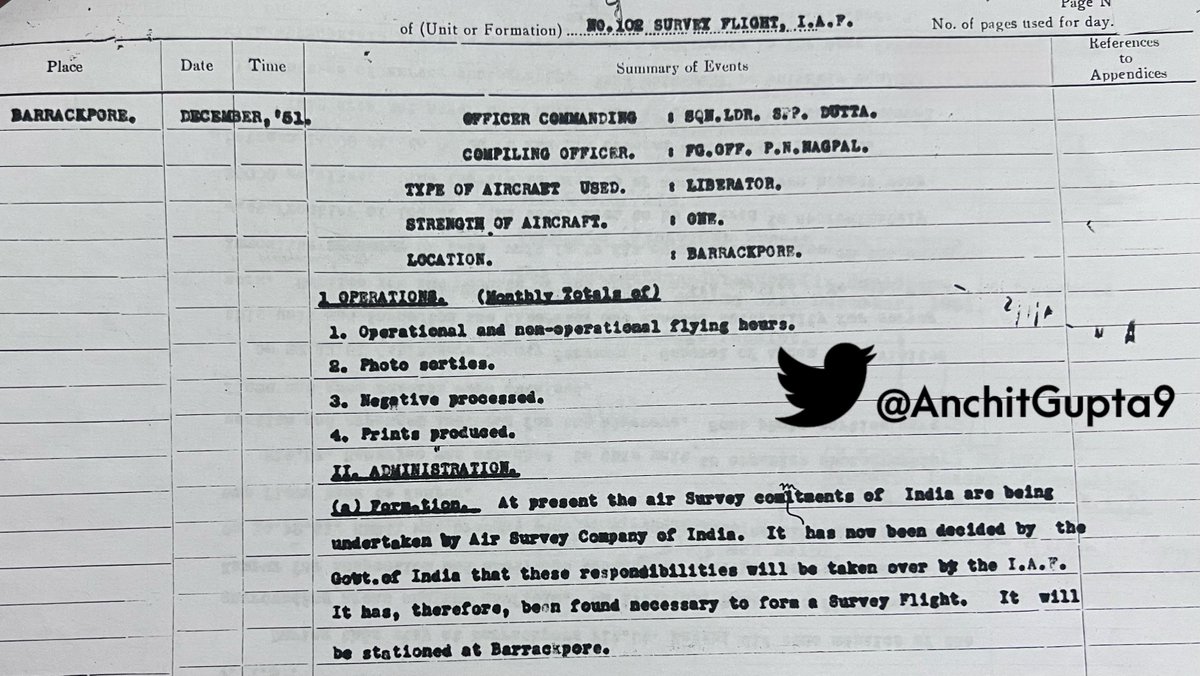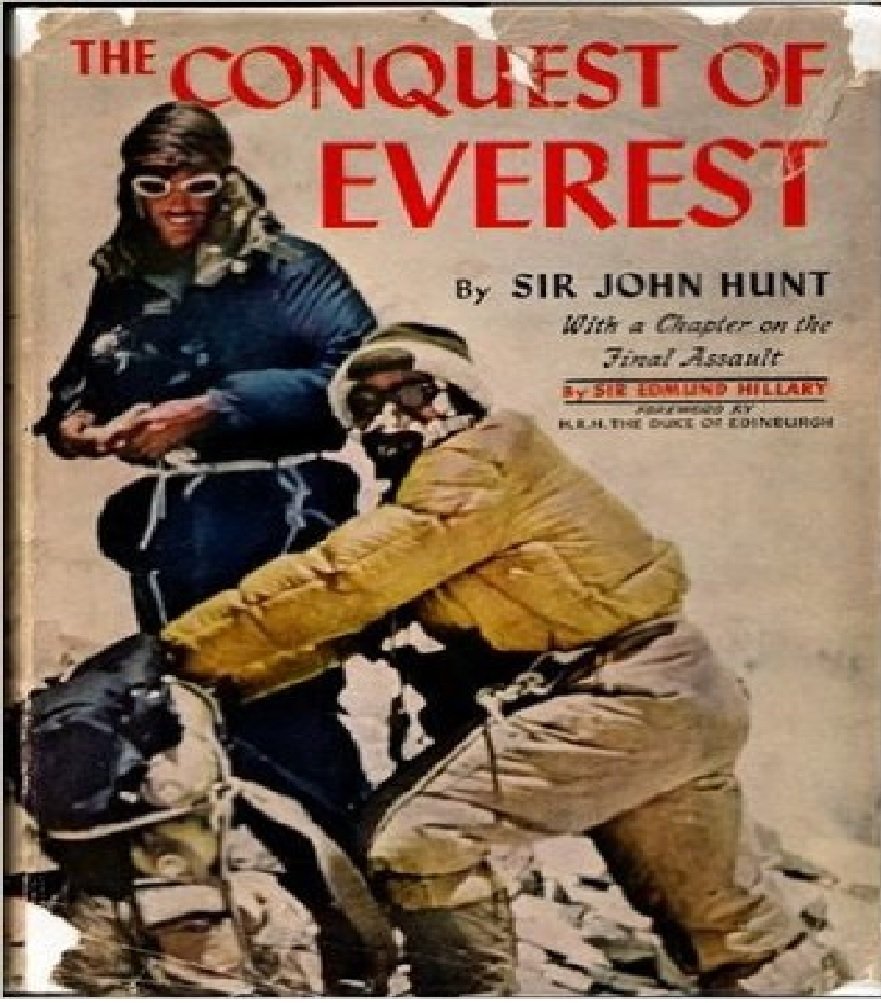
In 1953 @IAF_MCC made its maiden flight over Mt. Everest in a WWII vintage Liberator C-87, secretly synced with Edmund Hilary’s epic summit of the peak. This is the tale of the second ever photoreconnaissance flight over Everest & its stunning pictures. #IAFHistory (1/25) 

The idea was the brainchild of then Deputy chief (later chief) of the IAF, Aspy Engineer, with an intent to create global recognition for the IAF, conduct aerial photography of Everest never taken before, and fund-raise for a noble cause. But we must rewind a few years..2/ 

After ’47 Kashmir war, a need for Bomber aircraft was felt. Sabotaged B-24 Liberators left behind by RAF/USAAF were refurbished by IAF & HAL and put in service. 5 & 6 Sqn were equipped with 16 ac each by early 1951. But another jugaad was in the offing. 3/ 

Of the ac, two examples were the C-87 variant. The C-87 was aerodynamically cleaner & 20 knots faster than the B-24. It was nicked “The Liberator Express”. C-87s had most of the external protrusions, bombing & armament removed & the navigator's seat relocated aft of the pilot.4/ 

In late ’51, GoI decided that IAF should take over the air survey role, the immediate need was to survey 30,000 sqm of area over Mcmahon line. 102 Survey Flt was born on 15 Nov 51, out of 5 Sqn initially with the C-87 Liberator & based at Barrackpore. 5/ 

In Apr ’54 as Aspy gave the go-ahead, he chose the refurbished C-87 of 102 Flt to be tasked for the Everest Flight & IAF got down to planning in secrecy – To retain the awe of the flight, D-Day being the date on which John Hunt's mission summits Mt. Everest. 6/ 

The chosen ac, HE712 was originally with the USAAF & was transferred under Lend-Lease use to RAF. The RAF did not keep its Liberator C-87s long, disposing of the last examples in 1946. HE712 (EW634 in RAF colors) was last seen in service with 232 Sqn, RAF at Palam in Apr 46. 7/ 

The C-87 cargo hold had to be altered for the flight. Electrically heated suits - for crew & camera, had to be worn to guard against the extreme cold of high altitude. An equally dated, WWII Vintage, F24 Camera for stills and 16 mm color camera for cine was to be used. 8/ 

As the Hunt expedition established a base camp on 12 April ’53, IAF flew trial missions over Palam experimenting with mods & suits for photo men & equipment at an elevation of 35,000 feet, nearly 6,000 feet higher than Everest as well as the service ceiling of the C-87. 9/
The cameras had to be kept in electrically- heated covers to ensure smooth working & prevent the films from snapping. The cameraman could move around with portable oxygen cylinders, but still, the face was encumbered with the oxygen mask, & the hands ensconced in heavy gloves.10/
Around 20 May ’53, the expedition had reached the psychological milestone of the South Col, IAF was ready with crew & aircraft positioned at Palam. Apart from the aircrew, the manifest had four photographers – S/L SR Mullick & F/Ls BM Kothari, RN Banerjee & ND Jayal. 11/ 

The flight was planned from Gaya, southeast of Mt. Everest, about 250 km distance, traveled in about 75 minutes. This would allow sufficient time for the aircraft to loiter for photography. Lack of Met inputs meant weather (for flying or Photography) at Everest was a gamble 12/ 

Just days before the ascent, IAF had to sadly drop the plan to fly overhead in the interest of the climber’s safety. It was feared that loud noise from the 4-engine Liberator could trigger avalanches. The plan was revised to fly when the climbers recovered to lower reaches. 13/
Everest was summitted on 29 ‘May, announced on 2 June, same day as Queen’s coronation. On 6 June – the Liberator took off from Gaya at 8 am & headed northward in a steady climb. The ac required deft handling, as it was inclined to sluggishness beyond its service ceiling. 14/ 

At 15,000 ft the captain instructed the crew to put on the heated suits & don the masks. 75 minutes later, at 32,000 ft they were staring at the beauty and magnitude of Everest. Concerns of clouding abated, as it seemed Everest posed to the photographers. 15/ 

For an hour, they circled south of the peak & shot the region with four cameras, capturing every aspect & detail of Everest. Port holes were provided on the starboard side to enable aiming of camera lens. The cold draught at -27°C entered these ports, adding to challenges. 16/ 

These led to some filming stoppages & a second flight happened the next day. The complete absence of the famed Everest “plume” bode well for good photographic results. Later, the expedition mentioned having glimpsed the overhead ac when they were at Thyangboche monastery.17/ 

The still & cine photography had exceeded expectations & were going to expand human knowledge of Mt Everest. Capitalizing on the occasion, IAF offered these pictures to worldwide media publications for a fee, all the proceeds going to the IAF Benevolent Fund. 18/ 

Apart from worldwide instant print media recognition, “Conquest of Everest” a 1953 British Technicolor documentary film carried cine shots filmed by IAF. A one-minute extract of the IAF film can be seen here - youtube.com/clip/Ugkxjvhfj… 19/
C-87 Liberator of 102 SR Flt serial HE712 had put India on the global map. Its aircrew though, for reasons unknown was from 5 Sqn – F/L AE Paul as Captain, F/O SC Aurora as Co-pilot, F/O RK Dhagat as Navigator, Sgt AK Sarker (Eng) & Sgt. AE Lakra (Radio). 20/ 

C-87s were USAAF mainstay for cargo transport between US & China/ Burma during WWII. For every 1,000 tons transported in a C-87, 3 aircrews were lost! That IAF managed to pull off the Everest Flight without a hitch & much ado, was no mean feat. 21/ 

Liberator msns to Everest continued in the years to come. IAF repeated this photography feat, 12 years later in June ’65 in an An-12 aircraft, exactly a week after Capt MS Kohli & team of 9 mountaineers became the first Indians to ascend the peak. 22/ 

In 1980, PM Indira Gandhi inaugurated a new building for the Indian Mountaineering Foundation and donated the originals of Mt. Everest pictures taken by IAF to them. It is hoped these have survived the passage of time. 23/ 

HE712 was “struck-off charge” in Nov ’61. It would have been a worthy relic as IAF’s C-87 & to have made the Everest Flight…
If you missed reading about the first flight over Everest in 1933, read up here -
If you missed reading about the first flight over Everest in 1933, read up here -
https://twitter.com/anchitgupta9/status/154649215758167654624/
This thread is dedicated to F/L Alfred Eric Wilfred Paul & Sgt Sarkar who were captain and Flt Engr of the pioneering flt & died 69 years ago today, on 27 Aug 53, in a B-24 at Poona. This thread commemorates the duo & their cohorts of HE712 for touching the sky with glory. 25/25 

• • •
Missing some Tweet in this thread? You can try to
force a refresh


















